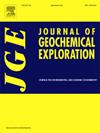某闭式尾矿厂产酸地球化学和矿物学控制因素的空间异质性影响研究
IF 3.3
2区 地球科学
Q1 GEOCHEMISTRY & GEOPHYSICS
引用次数: 0
摘要
矿物工业日益产生大量的尾矿,这些尾矿通常存放在尾矿储存库中。为了突出空间变异性对地球环境结果的影响,从不同地点的封闭TSF中收集了5个样本。表征结果用于研究样品位置的非均质物理、地球化学和矿物学性质。例如,黄铁矿的含量在0.02 ~ 8 wt%之间。同样,碳酸盐含量从0.05% wt%到43% wt%不等。为评估产酸潜力而进行的静态试验得出了关于产酸潜力的各种结果。因此,在解释每个静态试验时,不应忽视其局限性和试验操作条件下的矿物学含义。因此,对所选样品进行了彻底的矿物学表征,以突出其固有的矿物学差异。此外,利用风化室试验进行的动力学测试强调,样品C1和C2是产酸的,而C3、C4和C5在整个测试期间保持环中性到碱性的pH值。C2、C3、C4和C5样品的铁释放可以忽略不计,这是由于其在环中性条件下以次级铁氧化物的形式沉淀,包裹在黄铁矿上。利用PHREEQC建立动力学模型,对硅酸盐的中和滞后时间以及方解石耗竭对铁和硫酸盐释放的影响进行了参数化分析。该模型的主要结果强调,至少20%的钠长石应包括在方解石为基础的修正,以防止铁释放方解石枯竭或钝化。本文章由计算机程序翻译,如有差异,请以英文原文为准。
Investigating the spatial heterogeneity impact on the geochemical and mineralogical controlling factors framing acid generation at a closed tailings facility
Mineral industry is increasingly generating massive amounts of tailings, usually deposited in tailings storage facilities (TSF). To highlight the spatial variability effect on the geoenvironmental outcomes, five samples were collected from a closed TSF from different locations. The characterization findings were used to investigate the heterogeneous physical, geochemical, and mineralogical properties depending on the sample location. For instance, the pyrite content spans the interval between 0.02 and 8 wt%. Likewise, the carbonate content varies from 0.05 wt% to 43 wt%. Static tests performed to assess the potential of acid generation yielded various findings regarding the acid generation potential. Therefore, each static test should be interpreted without overlooking its limitations and the mineralogical implications under the test operating conditions. Hence, a thorough mineralogical characterization was undertaken for the selected samples to highlight their inherent mineralogical differences. Additionally, kinetic testing using weathering cell tests, highlighted that the samples C1 and C2 are acid generating, whereas C3, C4 and C5 maintain circumneutral to alkaline pH throughout the testing period. Iron release was negligible for the samples C2, C3, C4 and C5 due to its precipitation as secondary iron-oxyhydroxides that coated pyrite in circumneutral conditions. A kinetic model was established using PHREEQC to perform a parametric analysis regarding the neutralization lag time of silicates as well as the effect of calcite depletion on iron and sulfate release. The main outcome of the model underline that at least 20 wt% albite should be included in a calcite-based amendment to prevent iron release upon calcite depletion or passivation.
求助全文
通过发布文献求助,成功后即可免费获取论文全文。
去求助
来源期刊

Journal of Geochemical Exploration
地学-地球化学与地球物理
CiteScore
7.40
自引率
7.70%
发文量
148
审稿时长
8.1 months
期刊介绍:
Journal of Geochemical Exploration is mostly dedicated to publication of original studies in exploration and environmental geochemistry and related topics.
Contributions considered of prevalent interest for the journal include researches based on the application of innovative methods to:
define the genesis and the evolution of mineral deposits including transfer of elements in large-scale mineralized areas.
analyze complex systems at the boundaries between bio-geochemistry, metal transport and mineral accumulation.
evaluate effects of historical mining activities on the surface environment.
trace pollutant sources and define their fate and transport models in the near-surface and surface environments involving solid, fluid and aerial matrices.
assess and quantify natural and technogenic radioactivity in the environment.
determine geochemical anomalies and set baseline reference values using compositional data analysis, multivariate statistics and geo-spatial analysis.
assess the impacts of anthropogenic contamination on ecosystems and human health at local and regional scale to prioritize and classify risks through deterministic and stochastic approaches.
Papers dedicated to the presentation of newly developed methods in analytical geochemistry to be applied in the field or in laboratory are also within the topics of interest for the journal.
 求助内容:
求助内容: 应助结果提醒方式:
应助结果提醒方式:


